서 론
최근 서구화된 식생활과 신체활동 감소로 생활습관병이 발병하여 건강에 대한 관심이 높아지고 있으며 여러 질병의 주된 원인으로 인체 내 호흡과정 중 발생하는 산화 생성물인 free radical은 superoxide radical(O2-), hydrogen peroxide(H2O2), hydroxy radical(OH-)과 같은 활성산소종이 있다(1,2). 활성산소종은 외부로부터 침입하는 세균을 대식세포가 제거하는 과정 등 정상적인 생명현상의 유지에 필수적인 역할을 담당하고 있으나, 이러한 물질들이 생체 내 과도하게 생성됨으로 산화 스트레스 및 반응이 일어날 경우 반응시간이 매우 짧은 반면 반응력이 커서 세포막의 파괴와 유전자 손상, 염증과 노화, 돌연변이, 암 등의 질환을 유발시킨다(3,4). 이러한 활성산소종은 염증을 유발하는 과정에서 자기방어를 위한 수단으로 생성되는데 인체에서 세균과 같은 감염원을 공격하는 것이 아닌 자신의 조직 또한 구별없이 공격을 함으로 염증이 유발된다(5). 따라서 지속적인 염증반응은 점막손상을 촉진할 뿐 아니라 주변 조직을 손상시켜 질병의 상태를 악화시킬 수 있으며 특히 염증 매개물질들 중 산화질소는 산화질소 합성효소가 L-arginine을 산화시켜 생성한 물질로 nitric oxide가 과다하게 생성될 경우 염증을 유발하거나 악화시켜, 폐, 대장, 구강 등에 종양을 발생시키기도 한다(6,7). 활성산소종과 염증인자의 발현을 억제하는 물질은 잠재적으로 항염증, 항암효과의 유용한 인자로서 개발가능성이 대두되고 있다(8).
황금(Scutellariae Radix)은 한국, 중국, 몽골 및 시베리아 동부지역에 분포하고 있고 우리나라에서는 남부지방 산지의 풀밭에서 자라며, 쌍떡잎 식물 꿀풀과(Labiatae)에 속하는 초본식물 속썩은 풀(Scutellaria baiclensis Gerogi)의 뿌리로서 주피를 제거하거나 뿌리 그 자체를 한약으로 사용하고 있다(9,10). 예로부터 소염, 해열, 변비, 위장염, 알레르기 및 천식의 치료로 사용되어왔으며 약리작용으로는 항천식작용, 항암작용, 항균작용, 항산화 활성, 항고지혈 효과, 생체보호작용, 면역조절기능 등이 보고되어 있다(11,12). 황금의 활성을 나타내는 주요성분으로 baicalin, baicalein, wogonin 등의 flavonoid류가 있고 이와 같은 유효성분에 대한 연구는 여러차례 이루어진 바 있으며 이들 성분은 산화 메커니즘 내 활성산소 생성을 억제하는 항산화 작용과 더 나아가 활성산소의 생성을 차단함으로써 염증의 확산을 방지하는 항염증 작용, 항고혈압, 항알레르기, 항균, 항바이러스 등의 효과를 가지는 것으로 보고된 바 있다(13,14). 천연물 내 생리활성물질을 효율적으로 추출하기 위해 추출용매의 종류, 추출 온도 및 시간에 따라 추출되는 유효성분이 달라지며(15), 황금의 생리활성물질은 열수추출에서는 잘 녹지 않아 메탄올, 에탄올 및 아세톤과 같은 용매를 사용함으로 추출이 용이하다고 보고되고 있다(16,17). 현재까지는 황금 추출물의 항산화, 항염증에 대한 선행연구는 있었으나 대부분 열수추출물에 대한 연구결과가 보고되고 있다.
따라서 본 연구에서는 황금의 생리활성물질을 추출하기 위해 메탄올 및 식품추출 용매로 사용되는 열수 및 에탄올을 사용하여 황금 추출물을 제조한 다음, 추출용매별 항산화 활성 및 암세포 증식 억제 효과를 분석하고 기능성 소재로의 활용 가능성을 확인하였다.
재료 및 방법
본 실험에 사용된 황금은 주피를 제거한 뿌리로 미륭생약(주)(Pocheon-si, Gyeonggi-do, Korea)에서 구입하였고 상온에서 보관하면서 분쇄기(FM-909, Hanil Co., Sejong, Korea)로 분쇄 후 표준망체(60 mesh, Chung Gye Sang Cong Sa, Seoul, Korea)를 통과한 분말을 추출용 시료로 사용하였다.
추출용매에 따른 황금 추출물 제조는 30 g의 황금분말에 증류수, 80% 에탄올 및 80% 메탄올을 고형분 대비 10배 첨가하여 증류수 첨가군은 100℃에서, 80% 에탄올 및 80% 메탄올 첨가군은 각각 80℃에서 4시간 동안 환류냉각추출기(CA-1112, Eyela CO., Tokyo, Japan)를 이용하여 추출하였다. 각각의 추출물은 불순물을 제거하기 위하여 여과지(NO.4, Whatman International Ltd., Leicestershire, England)를 사용하여 여과시켰다. 여과된 추출물은 감압농축기(N-1N, Eyela CO., Tokyo, Japan)로 농축한 다음, 동결건조기(Free Zone 2.5, Labconco Co., Kansas, MO, USA)를 이용하여 건조 후 -70℃ 이하의 암소에서 보관하며 분석용 시료로 사용하였다.
총 폴리페놀 함량은 Folin-Denis법(18)에 따라 시료 1 mL에 1 N Folin-Ciocalteu reagnet 1 mL를 첨가하여 반응시킨 후 20% sodium carbonate 1 mL를 첨가하고 실온의 암소에서 30분간 반응한 다음 분광광도계(Ultraspec 2100pro, Biochrom Ltd., Cambridge, UK)를 사용하여 725 nm에서 흡광도를 측정하였다. 총 폴리페놀 함량은 tannic acid(Sigma-Aldrich Co., St. Louis, MO, USA)를 정량하여 작성한 표준곡선을 이용하여 계산하였다.
총 플라보노이드 함량은 Davis법(19)에 따라 시료 1 mL에 5% NaNO2 0.5 mL를 첨가하여 6분간 실온에서 방치 후 10% AlCl3 0.3 mL를 첨가하고 실온에서 5분간 반응시켜 1 N NaOH 1 mL와 혼합한 다음 분광광도계(Ultraspec 2100pro, Biochrom Ltd.)를 사용하여 510 nm에서 흡광도를 측정하였다. 총 플라보노이드 함량은 Rutin(Sigma-Aldrich Co.)을 정량하여 작성한 표준곡선을 이용하여 계산하였다.
ORAC 측정은 Talcott와 Lee(20)의 방법을 이용하여 황금 추출물 동결건조분말 및 Trolox를 농도별로 희석하였는데 실험용 시료의 제조에는 중성 phosphate buffer(61.6:38.9, v/v, 0.75 M K2HPO4 and 0.75 M NaH2PO4)를 사용하였다. 검량 곡선을 작성하기 위하여 항산화 활성 비교 표준액으로 Trolox(water soluble analogue of vitamin E, 6-hydroxy-2,5,7,8-tetramethylchroman-2-carboxylic acid, Sigma-Aldrich Co.) 10 μL를 phosphate buffer 50 mL에 용해하여 제조하였고, 측정기기는 fluorescent micro plate reader(Infinite M200 PRO, Tecan Co., Salzburg, Austria)를 이용하여 485 nm에서 전자가 여기되고 538 nm에서 방출되게 조절하여 본 실험에 사용하였다.
DPPH(1,1-diphenyl-2-picrylhydrazyl) radical 소거활성은 안정한 free radical인 DPPH의 환원력을 이용하여 측정하였다(21). DPPH reagent는 DPPH(Sigma-Aldrich Co.) 0.012 g을 99.9% ethanol에 충분히 용해시킨 후 동일한 양의 증류수를 첨가하여 제조하였다. 시료 0.5 mL에 DPPH reagent 시약 5 mL를 첨가하여 혼합 후 실온에서 15분간 반응시켜 준 다음 분광광도계(Ultraspec 2100pro, Biochrom Ltd.)를 사용하여 517 nm에서 흡광도를 측정하였다. DPPH radical 소거활성은 시료 첨가 전과 후의 차이를 아래와 같이 계산하여 나타내었다.
ABTS(2,2-azino-bis(3-ethylbenzothianzoline-6-sulfonic acid)) radical 소거활성은 양이온(ABTS+)에 대한 항산화물질의 소거능을 이용하여 측정하였다(22). ABTS reaction mixture는 7.4 mM ABTS(Sigma-Aldrich Co.)와 2.6 mM K2S2O8의 농도로 제조하고 실온인 암소에서 24시간 동안 반응시켜 ABTS free radical을 생성시킨 후 732 nm에서 흡광도 값이 0.7±0.03이 되게 증류수를 사용하여 희석하였다. 시료 50 μL에 ABTS reaction mixture 950 μL를 첨가하여 혼합 후 실온에서 10분간 반응시켜 준 다음 분광광도계(Ultraspec 2100pro, Biochrom Ltd.)를 사용하여 732 nm에서 흡광도를 측정하였다. ABTS radical 소거활성은 시료 첨가 전과 후의 차이를 아래와 같이 계산하여 나타내었다.
FRAP 측정은 Benzie와 Strain(23)의 방법에 따라 산화 및 환원능력을 이용하여 측정하였다. FRAP reagent는 300 mM acetate buffer(pH3.6) 25 mL에 40 mM HCl에 용해한 10 mM 2,4,6-tris(2-pyridyl)-s-triazine(TPTZ, Sigma-Aldrich Co.) 2.5 mL와 20 mM ferric chloride solution(FeCl3·6H2O) 2.5 mL를 혼합하여 제조하였다. 시료 25 μL에 실험직전 37℃에서 10분 이상 반응시킨 FRAP reagent를 175 μL 첨가한 후 37℃ 암소에서 30분간 반응시켜 준 다음 분광광도계(Ultraspec 2100pro, Biochrom Ltd.)를 사용하여 590 nm에서 흡광도를 측정하였다. FRAP 측정은 FeSO4·7H2O (Sigma-Aldrich Co.)를 정량하여 작성한 표준곡선을 이용하여 계산하였다.
환원력 측정은 Oyaizu(24)의 방법에 따라 활성산소종 및 유리기에 전자를 공여하는 능력을 이용하여 측정하였다. 시료 1 mL에 0.2 M phosphate buffer(pH 6.6) 2.5 mL와 1% potassium ferricyanide 2.5 mL를 가한 후 50℃에서 30분간 반응시켰다. 반응 후 10% trichloroacetic acid 2.5 mL를 첨가하여 원심분리한 다음, 상등액 2.5 mL에 증류수 2.5 mL와 0.1% FeCl3 0.5 mL를 혼합한 다음 분광광도계(Ultraspec 2100pro, Biochrom Ltd.)를 사용하여 700 nm에서 흡광도를 측정하였다.
세포배양에 사용한 세포주는 인간 폐상피세포(L132), 마우스 대식세포(RAW264.7), 인간 위암세포(SNU719), 인간 폐암세포(A549) 및 인간 대장암세포(HT29)를 한국 세포주 은행(KTCC, Seoul, Korea)에서 분양받아 실험에 사용하였다. L132 및 RAW264.7 세포주는 DMEM배지(Welgene CO., Daegu, Korea)를 이용하였으며, SNU719, A549 및 HT29 세포주는 RPMI 1640배지(Welgene CO.)를 이용하여 각각 10% fetal bovine serum(Gibco BRL Co., Grand Island, NY, USA) 및 1% penicillin streptomycin(Gibco BRL CO.)을 첨가하여 37℃, 5% CO2 incubactor(MCO-18AIC, Sanyo Co., Osaka, Japan)에서 배양하였다.
세포독성은 methyl thiazol-2-YL-2,5-diphenyl tetrazolium bromide(MTT) assay Meerloo 등(25)의 방법에 따라 L132 및 RAW264.7 세포에 대한 독성을 측정하였다. 배양된 세포주를 1×104 cell/well 및 5×104 cell/well의 농도로 96 well plate에 첨가하여 24시간 배양하고 새로운 배지에 시료를 농도별로 처리한 다음 24시간 동안 배양하였다. 배양 후 PBS 완충용액에 녹인 methyl thiazol-2-YL-2,5-diphenyl tetrazolium bromide(MTT 5 mg/mL, Sigma-Aldrich Co.)를 각각의 well에 10 μL씩 첨가하고 4시간 동안 배양하여 MTT가 환원되게 하였다. 배양종료 후 상등액을 완전히 제거하여 dimethyl sulfoxide(DMSO, Junsei Chemical Co., Tokyo, Japan)를 100 μL씩 각각의 well에 첨가하고 실온에서 10분간 반응시켜 완전히 용해한 다음 microplate reader(UVM-340, Asys Co., Biochrom Ltd.)를 사용하여 540 nm에서 흡광도를 측정하였다.
L132 세포보호 효과는 Hwang(26)의 방법에 따라 과산화수소에 의한 세포사멸의 보호 효과를 확인하고자 측정하였다. 배양된 L132 세포를 1×104 cell/well의 농도로 96-well plate에 100 μL씩 첨가하여 24시간 배양하고, 새로운 배지에 1.5 mM H2O2와 시료를 농도별로 10 μL씩 각각의 well에 첨가하여 12시간 동안 배양하였다. 배양종료 후 PBS 완충용액에 녹인 MTT용액(5 mg/mL)을 각각의 well에 10 μL씩 첨가하고 4시간 동안 배양하여 MTT가 환원되게 하였다. 배양 후 상등액을 완전히 제거한 다음 DMSO를 100 μL씩 각각의 well에 첨가하고 실온에서 10분간 반응하여 완전히 용해시킨 다음 microplate reader(UVM-340, Asys Co.)를 사용하여 540 nm에서 흡광도를 측정하였고 시료의 흡광도를 대조군의 흡광도에 대한 백분율로 나타내었다.
RAW264.7 세포를 5×104 cell/well의 농도로 96-well plate에 100 μL씩 첨가하여 24시간 배양하고, 새로운 배지에 lipopolysaccharide(LPS 0.1 μg/mL, Sigma-Aldrich Co.)와 시료를 농도별로 10 μL씩 각각의 well에 첨가하고 24시간 동안 배양하였다. 배양종료 후 상등액 50 μL에 동량의 Griess 시약(Sigma-Aldrich Co.) 50 μL를 혼합하여 10분간 반응시킨 다음 microplate reader(UVM-340, Asys Co.)를 사용하여 540 nm에서 흡광도를 측정하였고 nitric oxide 생성량은 sodium nitrite(Sigma-Aldrich Co.)의 표준곡선을 이용하여 계산하였다.
배양된 3종의 암세포주 SNU719, A549 및 HT29를 2×104 cell/well의 농도로 96-well plate에 100 μL씩 첨가하여 24시간 배양하고, 시료를 농도별로 10 μL씩 각각의 well에 첨가하고 48시간 동안 배양하였다. 배양종료 후 PBS 완충용액에 녹인 MTT용액(5 mg/mL)을 각각의 well에 10 μL씩 첨가하고 4시간 동안 배양하여 MTT가 환원되게 하였다. 배양 후 상등액을 완전히 제거한 다음 DMSO를 100 μL씩 각각의 well에 첨가하고 실온에서 10분간 반응하여 완전히 용해시킨 다음 microplate reader(UVM-340, Asys Co.)를 사용하여 540 nm에서 흡광도를 측정하였고 시료의 흡광도를 대조군의 흡광도에 대한 백분율로 나타내었다.
결과 및 고찰
추출용매에 따른 황금 추출물의 수율, 총 페놀, 총 플라보노이드 함량 및 ORAC 값은 Table 1과 같다. 추출수율은 각각 열수추출물, 80% 에탄올 및 80% 메탄올 추출물에서 유의적인 차이를 나타내었으며 열수추출물에서 42.56%로 80% 에탄올 및 80% 메탄올 추출물의 19.47-19.57%보다 높은 수율을 나타내었다. Kim 등(27)은 생약재 열수추출물의 연구에서 황금 열수추출물의 수율이 40% 이상으로 높게 나타났다고 보고하여 본 연구와 유사한 결과를 나타내었다.
총 페놀 및 총 플라보노이드 함량은 열수추출물에서 16.73 g/100 g 및 2.86 g/100 g, 80% 에탄올 추출물에서 25.57 g/100 g 및 3.85 g/100 g, 80% 메탄올 추출물에서 26.44 g/100 g 및 4.23 g/100 g으로 나타나 유기용매 추출물이 상대적으로 높은 함량을 나타내었으며 특히 80% 메탄올 추출물에 가장 많이 함유되어 있었다. Park 등(28)은 추출용매에 따른 울금 추출물의 폴리페놀 및 플라보노이드 함량에서 열수추출물보다 유기용매 추출물 중 메탄올 추출물에서 높은 함량을 나타내어 본 연구결과와 유사하였다. 페놀성 화합물은 식물계에 널리 분포되어있는 2차 대사산물 중 하나로서 플라보노이드와 탄닌이 주성분이고 phenolic hydroxyl(OH)기를 가지므로 단백질 및 기타 거대 분자들과 쉽게 결합을 하며 항산화, 항암 등의 다양한 생리활성을 가지는 것으로 알려져 있어(29) 본 연구에서 페놀화합물 함량이 가장 많이 함유된 80% 메탄올 추출물이 열수 및 80% 에탄올 추출물보다 높은 항산화 활성효과가 나타날 것으로 사료된다.
ORAC 분석은 수소전달과 연관하여 AAPH에 의해 생성된 free radical에 대한 항산화물질의 소거능력을 측정함으로 식품 내 존재하는 hydrophobic 성분과 hydrophilic 성분 모두 반응하여 응용범위가 넓은 장점을 가진 방법이다(30). ORAC 측정결과 100 μg/mL 농도에서 열수추출물, 80% 에탄올 및 80% 메탄올 추출물이 각각 253.84 μM, 273.33 μM 및 274.23 μM로 나타났다. Park 등(31)은 황금의 항산화 효과는 baicalin, baicalein, oroxylin A 및 wogonin과 같은 polyhydroxy flavonoids에서 관찰됨을 확인하였다. Kim 등(32)은 ORAC 분석이 flavonoid, vitamin C등과 같은 phenol 물질들에 항산화능을 분석하는 방법으로 보고되어 황금의 페놀 및 플라보노이드 함량이 가장 높은 80% 메탄올 추출물에서 ORAC 활성이 높게 나타난 것으로 사료된다.
추출용매에 따른 황금 추출물의 DPPH 및 ABTS radical 소거활성은 Fig. 1과 같다. DPPH radical 소거활성은 100-1,000 μg/mL 농도에서 측정하였으며 열수추출물이 12.82-75.31%로 나타났고 80% 에탄올 및 80% 메탄올 추출물이 각각 15.89-84.79% 및 17.45-88.71%로 나타나 농도가 증가할수록 항산화 활성이 증가하는 것을 확인하였으며, 1,000 μg/mL 농도에서 80% 메탄올 추출물이 88.71%로 가장 높은 활성을 나타내었다. Cha 등(33)은 황금 지상부의 열수, 30% 메탄올, 60% 메탄올 및 100% 메탄올 분획물의 DPPH radical 소거활성을 측정한 결과 열수보다 60% 메탄올 및 30% 메탄올 분획물이 더 높은 활성을 나타내어 본 연구와 유사한 경향을 보였다. ABTS radical 소거활성은 친수성 및 소수성 물질의 항산화 활성에 모두 측정하는 방법(34)으로 농도가 증가함에 따라 유의적으로 증가하였으며, 열수추출물에서 19.54-66.63%, 80% 에탄올 및 80% 메탄올 추출물에서 각각 21.84-79.87% 및 26.58-85.05%로 나타나 DPPH radical 소거활성과 같이 1,000 μg/mL 농도의 80% 메탄올 추출물에서 85.05%로 높은 활성을 나타내었다. Cal 등(35)은 황금의 메탄올 추출물이 열수추출물보다 ABTS radical 소거능이 더 높다고 보고하여 본 연구와 유사하였으며, Chang 등(36)은 황금의 경우 에탄올 추출물이 열수추출물에 비해 항산화관련 유용성분 추출에 효과적임을 보고하였는데 본 연구에서도 80% 에탄올 및 80% 메탄올을 이용한 추출물에서 유용성분 추출이 용이하여 항산화 활성이 우수함을 확인하였다.
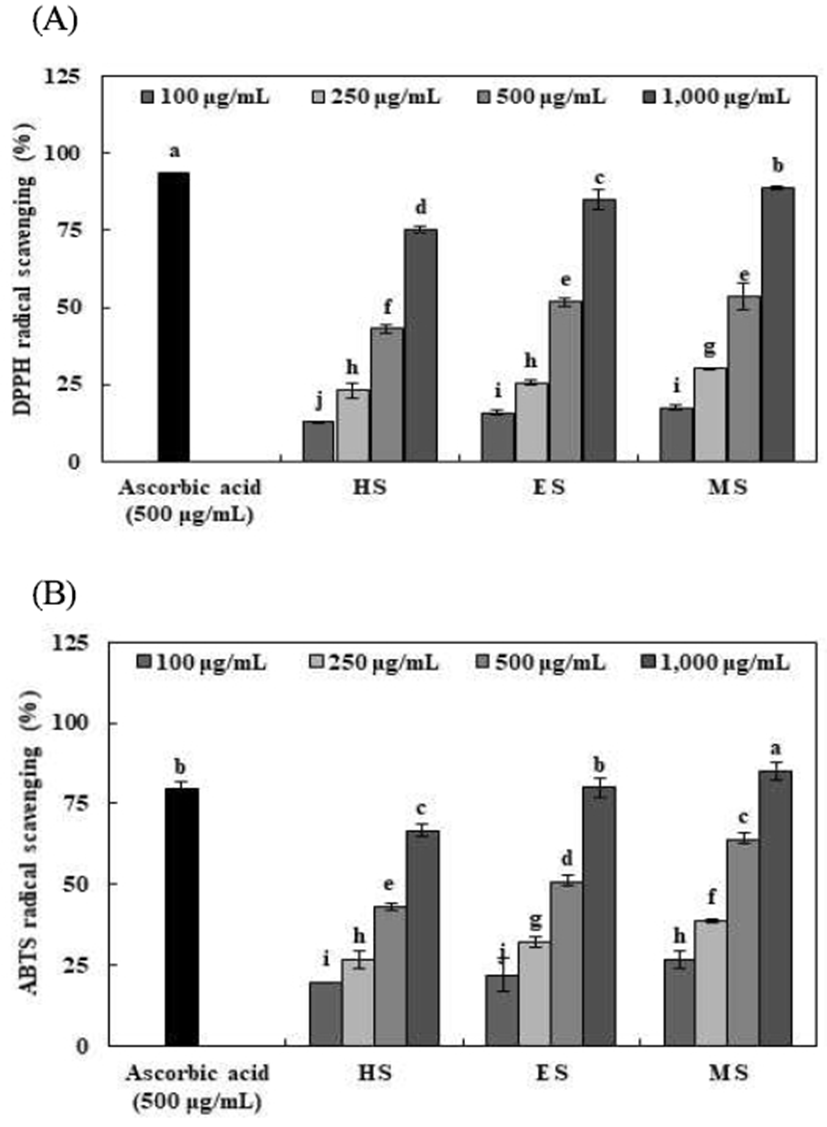
추출용매에 따른 황금 추출물의 FRAP 및 환원력은 Fig. 2와 같다. FRAP는 ferric-ferricyanide(Fe3+)혼합물이 유리라디칼을 안정화시켜 ferrous(Fe2+)로 전환하는 환원력을 이용한 방법으로 보고되어 있으며 황금 추출물을 측정해본 결과 100-1,000 μg/mL 농도에서 12.76-110.14 μM로 나타나 농도 의존적으로 항산화 활성이 증가하였으며 1,000 μg/mL 농도에서 열수추출물, 80% 에탄올 및 80% 메탄올 추출물이 각각 94.25 μM, 103.32 μM 및 110.14 μM의 활성을 나타내었다. 환원력은 100-1,000 μg/mL의 농도에서 분석한 결과 모든 구간에서 농도 의존적으로 활성이 증가하였으며 열수추출물, 80% 에탄올 및 80% 메탄올 추출물에서 각각 0.10-0.78, 0.13-0.91 및 0.12-1.01로 나타내 황금 추출물의 FRAP 및 환원력의 모두 80% 메탄올 추출물에서 우수한 항산화 활성을 확인하였다. 식물 원료의 환원력은 총 페놀 화합물의 함량에 의존적이며, 전자공여를 통한 라디칼의 소거활성과도 상관성이 높은 것으로 알려져 있어(37) 본 연구 결과에서도 총 페놀화합물, DPPH 및 ABTS radical 소거활성에서 높은 활성을 보인 80% 메탄올 추출물이 다른 시료에 비해 높은 FRAP 및 환원력을 나타낸 것으로 사료되어진다.
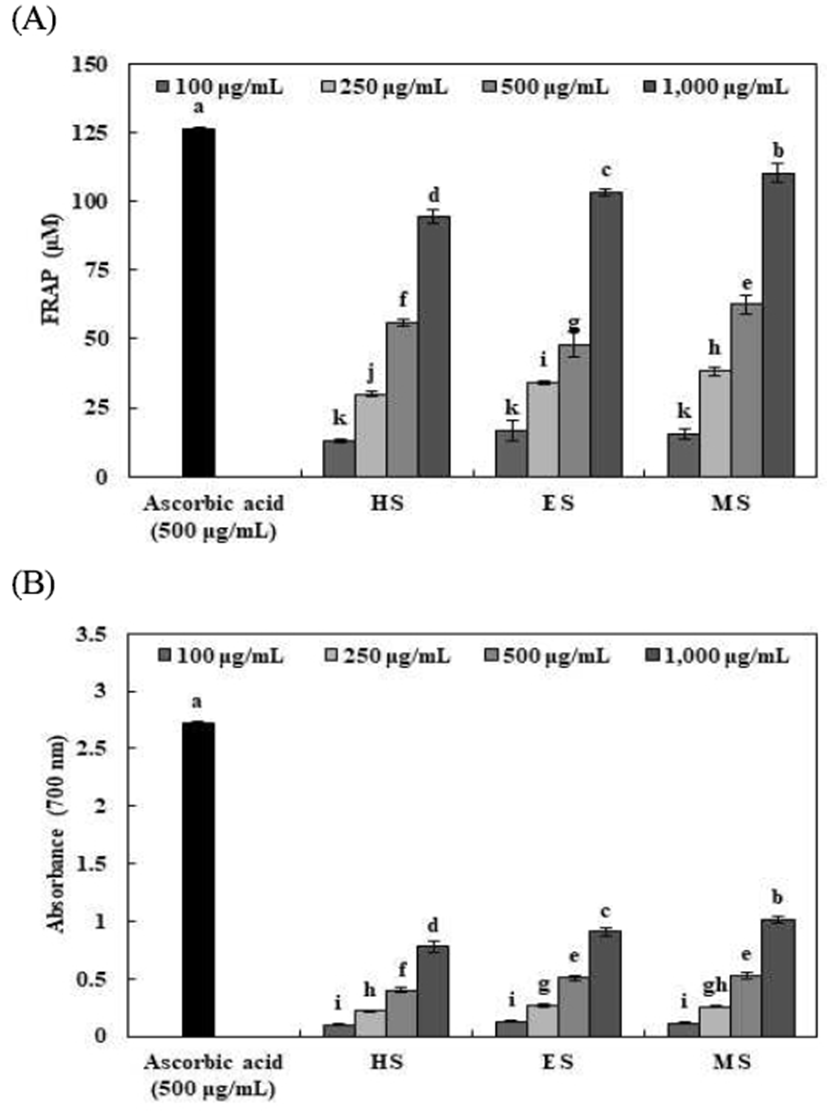
추출용매에 따른 황금 추출물을 인간 폐상피세포주인 L132에 농도별로 처리하여 MTT assay 방법으로 측정하였으며, 세포독성 및 L132 산화적 손상에 대한 세포보호 효과는 Fig. 3과 같다. 추출용매에 따른 황금 추출물을 10-100 μg/mL 농도로 처리하였으며 세포 생존율이 90.45-101.95%로 나타나 모든 농도에서 L132 세포에 대한 독성이 낮음을 확인하였고 다양한 농도에서 실험한 결과 유의적인 세포보호 효과가 나타나는 10-100 μg/mL 농도에서 실험하였다. 세포보호 효과는 모든 시료에서 1.5 mM H2O2 첨가구(60.08%)와 비교한 결과 항산화 활성이 유의적으로 증가하는 것을 확인하였다. 열수추출물이 60.78-73.02%로 나타났고 80% 에탄올 및 80% 메탄올 추출물이 각각 60.96-79.64% 및 62.64-85.11%로 나타났다. 100 μg/mL 농도에서 황금 추출물 모두 1.5 mM H2O2 대조군에 비해 17.72-41.63%로 높은 활성을 나타내었으며, 80% 메탄올 추출물이 85.11%로 세포보호 효과가 가장 높게 나타나 H2O2로부터 손상된 세포를 보호하는 효과가 가장 우수한 것을 확인하였다. Kim 등(38)은 glutamate로 유도된 세포독성으로부터 10 μg/mL 농도의 상백피 에탄올 추출물에서는 약한 활성을 보였지만 10 μg/mL 농도의 상백피 메탄올 추출물에서 70% 이상의 높은 활성을 보여 신경세포보호 효과를 나타내었다. 본 연구에서도 열수추출물 및 80% 에탄올 추출물보다 80% 메탄올 추출물에서 더 높은 세포보호 효과가 나타난 것을 확인하였다. 또한 Park(39)은 황금의 플라보노이드계 성분인 baicalein이 O2로부터 유도된 세포막파괴에 있어 세포보호 효과를 나타내었고 그 배당체인 baicalin은 ascorbate 첨가에 의해 상승적으로 ROS에 대항하여 세포를 보호한다고 보고하였다.
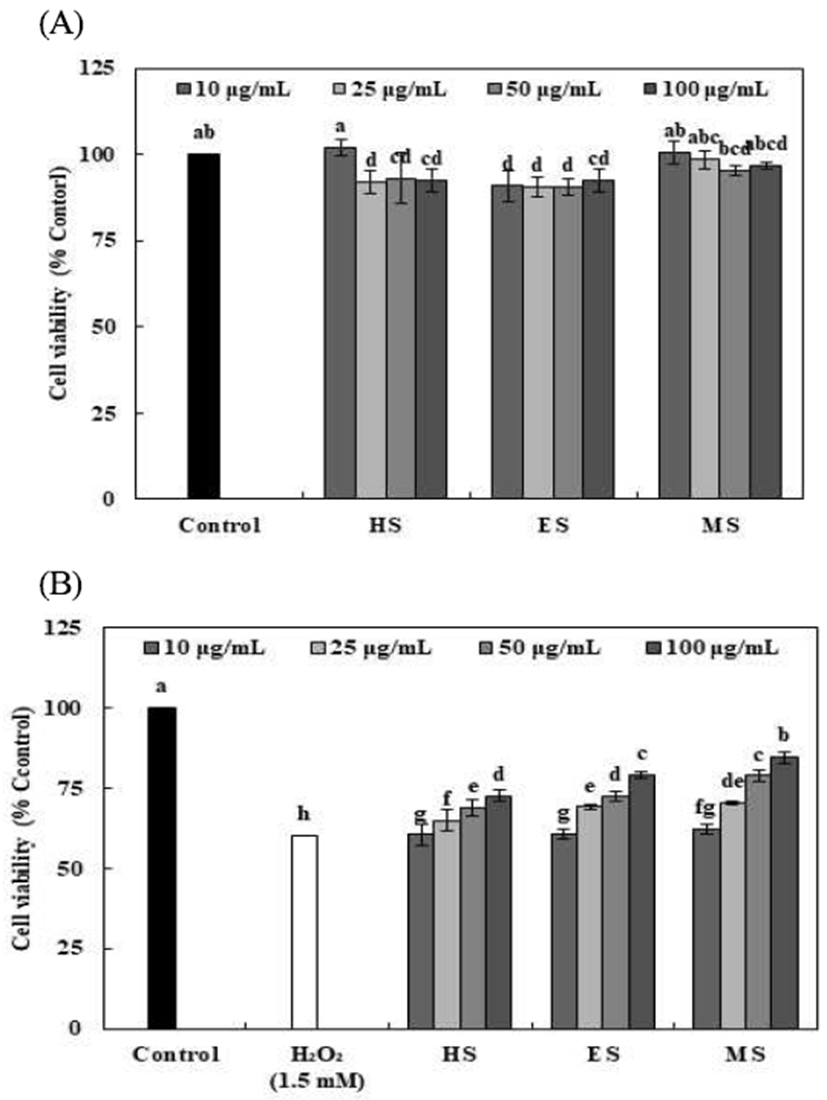
따라서 추출용매에 따른 황금 추출물 100 μg/mL 농도 이상에서 항산화 활성 및 과산화수소로 유도된 산화적 세포 사멸의 보호 효과가 나타나 항산화제 기능성 소재로 개발될 가능성이 있음을 나타내었다.
추출용매에 따른 황금 추출물을 마우스 대식세포인 RAW264.7에 농도별로 처리하여 MTT assay 방법으로 측정하였으며, 세포독성 및 RAW264.7 nitric oxide 생성 억제는 Fig. 4와 같다. 추출용매에 따른 황금 추출물을 1-25 μg/mL 농도로 처리하였으며 모든 구간에서 세포 생존율이 91.23-102.58%로 나타나 RAW264.7 세포에 대한 독성이 낮음을 확인하였고 인간 폐상피세포주 L132 cell을 이용한 세포보호 효과보다 저농도에서 유의적인 효과를 나타내어 1-25μg/mL 농도에서 nitric oxide 생성 억제 효과를 측정하였다.
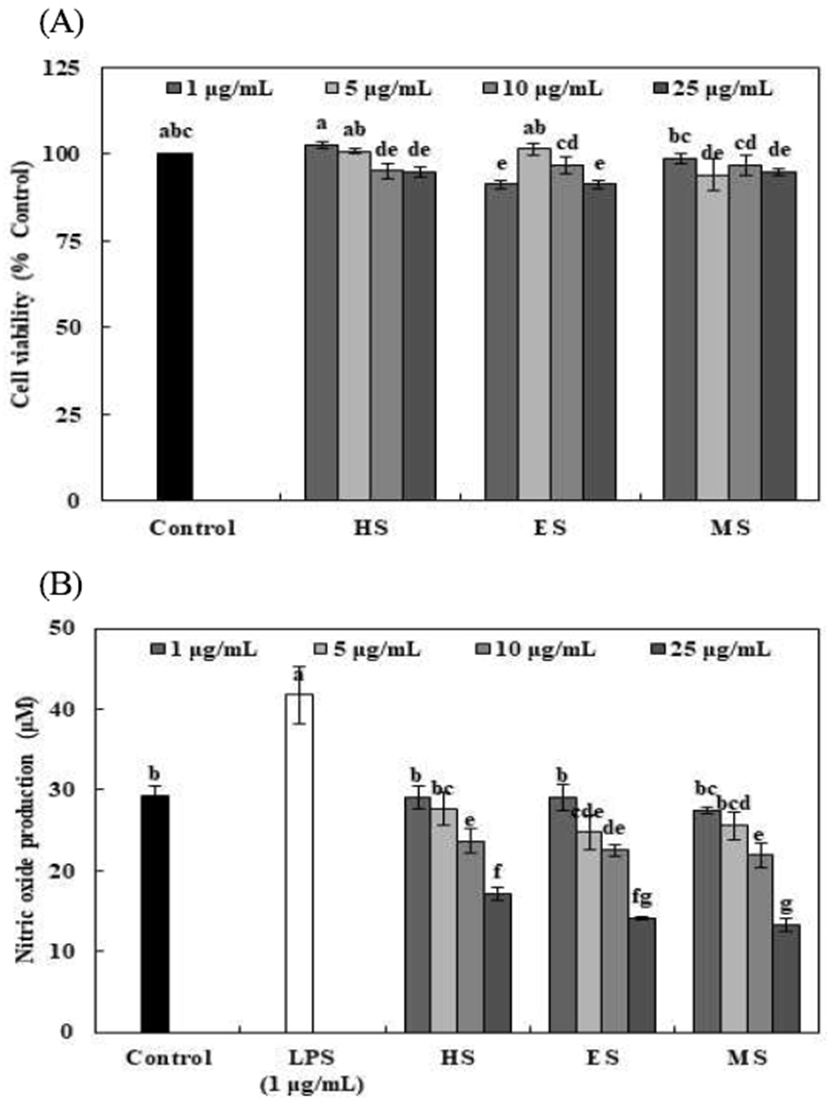
대식세포는 세균, 바이러스 등 미생물 및 생체의 이물질 등을 인식하면 활성화되어 염증 반응의 원인이 되는 많은 인자를 분비하여 염증에 대항하기도 하지만 과도한 면역인자 생성은 오히려 조직을 손상, 인체질환을 악화 및 종양의 성장을 돕는다(40). 모든 시료에 nitric oxide 생성을 유도하는 물질인 lipopolysaccharide(LPS)를 1 μg/mL 농도로 처리하였을 때 농도 의존적으로 nitric oxide 생성이 감소하였으며 열수추출물에서 29.10-17.16 μM, 80% 에탄올 및 80% 메탄올 추출물에서 각각 29.04-14.13 μM 및 27.46-13.28 μM로 나타났다. 특히 80% 메탄올 추출물 25 μg/mL 농도에서 13.28 μM로 나타나 LPS로 자극한 대조군(Control)함량 29.22 μM보다 nitric oxide 억제 효과가 우수한 것을 확인하였다. Hisa와 Choi(41)는 황금 및 인동 혼합추출물을 RAW264.7 세포에 25, 50, 200 μg/mL의 농도로 처리한 결과 유의하게 nitric oxide 생성을 억제함을 보고하였다. Chen 등(42)은 황금의 주요 플라보노이드인 baicalein이 nitric oxide를 생성하는 iNOS 발현을 억제하고 wogonin이 염증과 암 등의 질환에 중요한 역할을 하는 COX-2 발현을 억제한다고 보고하였다. 또한 Choi(43)는 nitric oxide 생성은 iNOS의 발현증가와 연관성이 높으며 iNOS의 과다생성은 대장암을 포함한 많은 암종의 생성과 진행을 촉진함으로 보고되어 nitric oxide의 생성 억제는 암의 예방 및 진행억제의 새로운 표적이 되고 있다. 따라서 본 연구 결과 80% 메탄올 추출물에서 nitric oxide 생성 억제 효과를 나타내 황금 내 주요 물질들이 작용한 것으로 사료된다.
추출용매에 따른 황금 추출물의 암세포주 인간 위암세포(SNU719), 인간 폐암세포(A549) 및 인간 대장암세포(HT29)에 대한 암세포 성장 억제 효능은 Fig. 5와 같다. 황금은 최근 체내에서 생성되는 암세포에서 세포주기 정지 및 세포 자멸사를 통해 항암활성을 가지는 것으로 보고되었다(44). 우리나라 사망원인 1위인 암 사망률 5위권에 있는 3종의 암세포에 추출용매에 따른 황금 추출물을 다양한 농도에서 실험한 결과 저농도에서 암세포 성장 억제 효과가 나타나지 않는 것을 확인하여 100-1,000 μg/mL 농도범위로 48시간 배양 후 MTT assay로 측정하였다. 추출용매에 따른 황금 추출물의 농도가 증가함에 따라 유의적인 암세포의 생존 저해 효과를 확인하였으며, 500 μg/mL 농도에서 SNU719, A549 및 HT29 암세포주 저해 효과는 열수추출물에서 99.62%, 63.68% 및 93.77%로 나타났고 80% 에탄올 추출물의 경우 92.08%, 61.46% 및 79.18%, 80% 메탄올 추출물에서 75.99%, 61.43% 및 67.01%로 나타내었다. 본 연구결과를 통해 각각의 추출용매에 따른 황금 추출물 중 80% 메탄올 추출물에서 다른 구간에 비해 낮은 암세포 생존율을 확인하여 암세포 성장 억제 효과가 높게 나타나는 것을 확인할 수 있었다. Kim(45)은 황금의 flavonoid 화합물 중 탁월한 항산화 효과가 알려진 수용성이 강한 ganhuangenin을 혈장, 간, 폐, 신장의 생체 내에서 항산화 효과를 확인한 결과 과산화물 생성에 높은 억제율을 나타낸 것으로 보고되어 본 연구에서도 황금의 화합물 내 수용성이 강한 물질의 반응에 의해 높은 암세포 저해 효과가 나타난 것으로 사료되어진다. Choi 등(46)는 열처리에 의한 황금 추출물의 항암활성 측정결과 무처리 열수추출물(1,000 μg/mL)은 폐암 및 위암세포에서 각각 67.3% 및 48.4%로 항암활성을 나타내 황금 추출물의 암세포 성장 저해 효과를 확인하였고 Jo 등(47)은 황금 열수추출물이 인간유래 자궁경부암 세포주인 SNU703에서 1.25 mg/mL 이상의 농도에서 세포의 증식률 감소를 나타내 암세포 성장 저해 효과를 보고하였다.
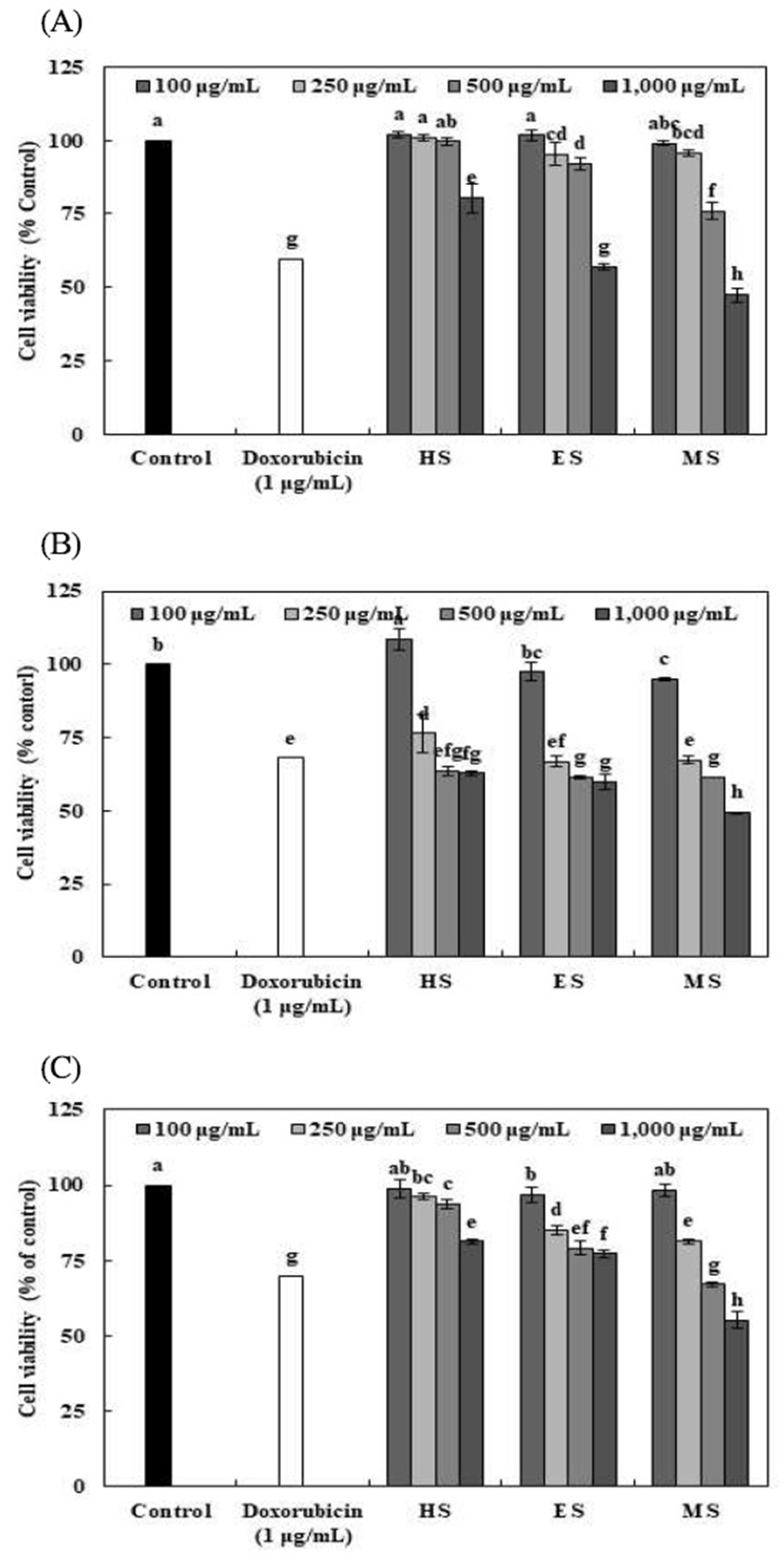
따라서 추출용매에 따른 황금의 항산화성 생리활성물질은 이화학적 품질특성, 항산화 활성, 항염증 효과(nitric oxide 생성 억제) 및 암세포주를 이용한 암세포 생육 저해 활성에 효과가 있는 것으로 판단되어 기능성 소재의 활용 가능성을 확인하였다.
요 약
본 연구에서는 유용성분을 함유하고 있는 한방소재인 황금을 기능성 소재로 활용하고자 열수, 80% 에탄올 및 80% 메탄올을 사용하여 추출물을 제조한 후 항산화 활성 및 암세포 증식 억제 효과를 조사하였다. 추출수율은 열수추출물에서 42.56%로 80% 에탄올 및 80% 메탄올 추출물보다 높게 나타났다. 총 페놀 및 플라보노이드 함량은 80% 메탄올 추출물에서 26.44 g/100 g 및 4.23 g/100 g으로 높은 함량을 나타내었다. ORAC 측정결과 100 μg/mL 농도에서 80% 메탄올 추출물이 274.23 μM로 가장 높은 활성을 보였다. DPPH radical 소거활성 및 ABTS radical 소거활성은 1,000 μg/mL 농도의 80% 메탄올 추출물에서 각각 88.71% 및 85.05%로 가장 높은 소거활성을 나타내었다. FRAP 및 환원력은 80% 메탄올 추출물 1,000 μg/mL 농도에서 110.14 μM 및 1.01로 가장 높은 활성을 나타내었다. 인간 폐상피세포주(L132)에서는 80% 메탄올 추출물 구간에서 H2O2를 처리한 구간 대비 높은 세포보호 효과를 나타내었다. Nitric oxide 생성 억제는 대조군(29.22 μM) 대비 80% 메탄올 추출물 구간에서 27.46-13.28 μM로 높은 nitric oxide 생성 억제 효과를 나타내었으며, 3종의 암세포(SNU719, A549 및 HT29) 생존율은 80% 메탄올 추출물 500 μg/mL 농도에서 75.99%, 61.43% 및 67.01%로 나타내 낮은 암세포 생존율을 보였다. 따라서 추출용매에 따른 황금 추출물의 항산화 활성 및 암세포 증식 억제 효과를 확인하여 기능성 소재로 활용 가능할 것으로 사료된다.










